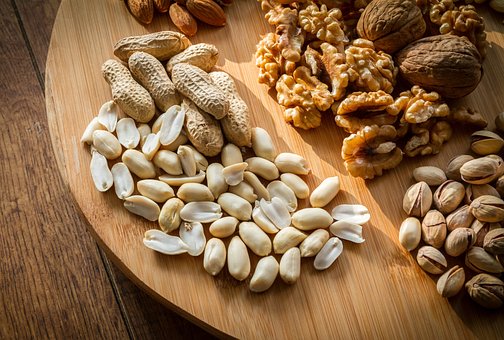Nuts are a great food to have on hand because they are crunchy, filling, and nutritious. Nuts have been shown to have a plethora of health benefits, one of which is maintaining a healthy body weight. They can also help reduce the risk of certain health conditions, such as heart disease.
Nuts are also an excellent food choice for kids. Studies have shown that adding nuts to your child’s diet can improve their intake of protein, healthy fats, and fiber.
Nuts have various textures, flavors, and nutrient profiles. There are many nutritious nuts that you can add to your diet. Some of the most nutritious nuts include almonds, walnuts, and pistachios.
1. Almonds
Almonds are popular for their taste, nutrition, and low price. You can consume almonds in a number of ways – raw, roasted, or as almond butter, flour, or milk.
A 1-ounce (28-gram) serving of roasted almonds contains:
- Calories: 170
- Fat: 15 grams
- Protein: 6 grams
- Carbs: 6 grams
- Fiber: 3 grams
- Vitamin E: 45% of the Daily Value (DV)
- Magnesium: 19% of the DV
- Manganese: 27% of the DV
Almonds contain a large amount of vitamin E, which is a nutrient that helps protect your cells from damage. Vitamin E also supports immune function and cellular communication.
Almonds are a good source of healthy fat, protein, fiber, and several vitamins and minerals. They may also reduce heart disease risk factors like elevated LDL (bad) cholesterol and excess belly fat.
A study done on 219 young adults found that those who ate 2 ounces of almonds daily had better cholesterol, less inflammation, and better blood sugar control than those who didn’t eat almonds.
The growth of beneficial gut bacteria, including Bifidobacteria and Lactobacillus species, may be promoted by almonds. Almonds are high in several essential nutrients. Eating them regularly may boost heart and gut health.
2. Pistachios
The pistachio nut’s name originates from the Greek word ‘pistákion’, which means “the green nut”. These nuts have been eaten since 6000 B.C.
Just 1 ounce (28 grams) of pistachios contains:
- Calories: 159
- Fat: 13 grams
- Protein: 6 grams
- Carbs: 8 grams
- Fiber: 3 grams
- Vitamin B1 (thiamine): 21% of the DV
- Vitamin B6: 28% of the DV
- Phosphorus: 11% of the DV
Pistachios are a good source of numerous nutrients, including vitamin B6, which your body needs for nutrient metabolism and immune function. Some of the other nutrients found in pistachios include magnesium, copper, and manganese.
Nuts are rich in plant compounds like the carotenoids lutein and zeaxanthin, as well as anthocyanins, flavonoids, and proanthocyanidins, which have significant antioxidant and anti-inflammatory properties.
In a 4-month study that included 100 people who were overweight, one group ate 1.5 ounces (42 grams) of pistachios per day and participated in a group-based behavioral weight loss program. The other group only participated in the weight loss program.
The two groups lost a comparable amount of weight, but the pistachio group had greater reductions in blood pressure and higher antioxidant levels in their blood. Not only that, but the experimental group also ate more fiber and fewer sweets than the control group.
Pistachios contain compounds which help to reduce inflammation and protect cells from damage. Additionally, they have the potential to improve blood pressure and other health indicators.
3. Walnuts
Walnuts have been linked to multiple health benefits and have an impressively nutrient-rich profile. Just 1 ounce (28 grams) contains:
- Calories: 185
- Fat: 18.5 grams
- Protein: 4 grams
- Carbs: 4 grams
- Fiber: 2 grams
- Copper: 50% of the DV
- Magnesium: 11% of the DV
- Manganese: 42% of the DV
Copper is a mineral that is essential for many processes in the body, including energy production and neurotransmitter synthesis. These nuts are a great source of copper. Copper is known to aid in immune function, blood vessel development, and more.
Walnuts are beneficial for heart health and may reduce the risk of several heart disease conditions, including high blood pressure, LDL (bad) cholesterol, and triglyceride levels.
Other research has shown that eating walnuts may help improve brain function and decrease the risk of developing dementia, as well as conditions such as heart disease and type 2 diabetes.
Although these findings are promising, more studies are needed. Walnuts, which contain high levels of copper and manganese, may improve heart and brain health.
The potential health benefits associated with consuming walnuts may include improve cardiovascular function and bone health, reducing the likelihood of developing gallbladder disease, and managing epilepsy.
Heart Health
The fatty acids in walnuts have been shown to decrease levels of LDL cholesterol, which is harmful, and triglycerides. In turn, this reduces the risk of cardiovascular disease, stroke, and heart attack.
The study found that people who consume nuts more than four times a week are 37 percent less likely to develop coronary heart disease than those who never or rarely consume nuts.
In 2013, scientists published findings of a small study which indicated that:
- walnut oil can benefit endothelial function
- whole walnuts can enhance the process of eliminating “bad” LDL cholesterol
A diet rich in walnuts was found to improve lipid and cholesterol profiles, according to a 2009 meta-analysis. The researchers also concluded that walnuts may also help reduce oxidative stress and inflammation, two conditions which are linked to various diseases.
4. Cashews
Cashews are versatile nuts that can go well with both savory and sweet dishes because of their crunchy texture and creamy mouthfeel. You can eat cashews raw, roasted, or as nut butter.
Only 1 ounce (28 grams) of raw cashews offers:
- Calories: 155
- Fat: 12 grams
- Protein: 5 grams
- Carbs: 9 grams
- Fiber: 1 gram
- Vitamin K: 8% of the DV
- Magnesium: 20% of the DV
- Manganese: 20% of the DV
The important vitamins and minerals in cashews include:
- calcium: 37 mg
- iron: 6.68 mg
- magnesium: 292 mg
- phosphorous: 593 mg
- potassium: 660 mg
Nutrients like protein, vitamin K, magnesium, and manganese found in these nuts are essential for bone health.
Some studies have explored whether there are benefits to including lots of cashews in your diet if you have metabolic syndrome, which is a group of conditions like high blood pressure, high blood sugar, and excess fat around the waist that raise your chances of developing heart disease and diabetes.
A review of five studies found that cashews can help lower blood pressure and triglyceride levels. However, some studies have observed mixed results, more research is needed to come to a conclusion.
Cashews may improve blood fat levels and reduce blood pressure, according to some studies. They also provide vitamins and minerals like magnesium and manganese.
Pecans are frequently used in baking and cooking because of their mild flavor. They are popular in desserts such as cakes and pies, as well as savory dishes such as salads and grain dishes.
One ounce (28 grams) of roasted pecans provides:
- Calories: 201
- Fat: 21 grams
- Protein: 3 grams
- Carbs: 4 grams
- Fiber: 3 grams
- Vitamin B1 (thiamine): 11% of the DV
- Zinc: 13% of the DV
- Manganese: 48% of the DV
Pecans are similar to other types of nuts in that they are high in healthy fats, fiber, vitamins, and minerals. Nuts are a good source of zinc. Zinc is important for immune function, wound healing, DNA synthesis, and growth and development.
Additionally, some research suggests that pecans benefit heart health. The study found that those who ate pecans daily had significant reductions in LDL (bad) cholesterol and triglyceride levels, compared with a control group.
Pecans are a good source of zinc and manganese, two nutrients that are beneficial to health. Among other benefits, they may promote heart health.
6. Peanuts
If you’re looking for a way to increase your protein intake, eating peanuts is a great option. Peanuts are widely available and provide several essential nutrients.
Although peanuts are a legume, most people consider them a nut.
Peanuts contain various polyphenols, antioxidants, flavonoids, and amino acids. These components have all been shown to be beneficial to health through research.
According to the nutrient database that the United States Department of Agriculture (USDA) has created, 100 g of peanuts contains 567 calories and the following quantities of other nutrients:
- protein: 25.80 g
- fat: 49.24 g
- carbohydrate: 16.13 g
- fiber: 8.50 g
- sugar: 4.72 g
Peanuts contain mostly healthy fats like monounsaturated and polyunsaturated fatty acids, with a smaller amount of saturated fats.
There are also plenty of minerals in 100 g of peanuts, including those below:
- calcium: 92 milligrams (mg)
- iron: 4.58 mg
- magnesium: 168 mg
- phosphorous: 376 mg
- potassium: 705 mg
Peanuts are more affordable than many other nut varieties.
7. Hazelnuts
Hazelnuts have a unique flavor that makes them a popular choice for sweet foods. Hazelnuts don’t have as much protein as other nuts, but they have other health benefits that make up for it.
Hazelnuts could potentially help lower cholesterol, according to a study that was published in the Journal of Clinical Lipidology. In the USDA database, 100 g of hazelnuts contains 628 calories as well as the following:
- protein: 14.95 g
- fat: 60.75 g
- carbohydrate: 16.70 g
- fiber: 9.7 g
- sugar: 4.34 g
Hazelnuts are more similar to walnuts in protein and fat content than to other types of nuts.
Hazelnuts contain mostly monounsaturated fats, but they also have some polyunsaturated and saturated fats. Hazelnuts also contain the following:
- calcium: 114 mg
- iron: 4.70 mg
- magnesium: 163 mg
- phosphorous: 290 mg
- potassium: 680 mg
Adding Nuts to Your Diet
People can increase the amount of nuts they eat to get more plant proteins. Below are some examples of ways to incorporate nuts into the diet:
Add them to Trail Mix
Nuts that have been roasted and seasoned with salt can enhance the flavor of a savory trail mix, which can be a healthier alternative to snacks such as chips.
Raw nuts are a good idea for a trail mix because they are healthy and full of nutrients. If you find yourself wanting to eat a candy bar or some other kind of sweet snack, sweet trail mix may help to satisfy that craving.
People on diets that are low in carbohydrates or sugar should be aware that dried fruits often have high sugar content.
Eat them as a Snack
Nuts are a convenient snack because they do not require any preparation. Nuts are high in calories, but they contain healthy fats.
Drink Nut Milk
While nut milk does not have the same properties as cow’s milk, it may be able to retain some of the flavor and benefits of the whole nuts.
Many grocery stores sell nut-based beverages, or people can make simple versions of nut milk at home to avoid added ingredients. Examples include almond milk, cashew milk, and hazelnut milk.
Use Nut Butters
There are several other types of nut butter in addition to peanut butter that can be bought at markets and grocery stores. People can add them to sandwiches or smoothies.
Sprinkle them on a Salad
A salad with a serving of nuts will have more protein and nutrients, making it a more filling meal.
Eating Too Many Nuts
Nuts are good for you because they can help reduce the chances of getting heart disease and other health problems. However, it is possible to eat too many nuts.
If you’re trying to lose weight, eating a lot of nuts throughout the day is not a good idea because they’re very high in calories. You might not realize it, but you could be eating more calories than you should be. Doing so regularly may lead to weight gain.
While nuts are high in healthy fats, eating too many can cause diarrhea and other issues.
Replacing other salty snacks with roasted, salted nuts can result in consuming just as much, if not more, sodium. If you are eating salted nuts, you should look at the label to see how much sodium is in them. Raw or dry-roasted nuts are a more healthful alternative.
Some people may find that nuts don’t agree with their stomach. If you overeat nuts, you may experience abdominal discomfort, including gas, cramping, or bloating. Nuts are also a common dietary allergy.
Nuts are generally safe and healthy to eat. Moderation is key, as nuts are calorie dense.
If you experience digestive upset after eating nuts, it may be a good idea to see a doctor. Some people may be unable to tolerate or be sensitive to specific aspects of nuts. Some people may not have been allergic to nuts before, but it is possible to develop an allergy to them.
If you have an allergic reaction, such as swelling or itching in your throat or face, stop eating nuts and get urgent medical care. Severe nut allergies can sometimes be fatal.









